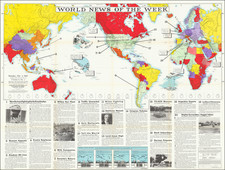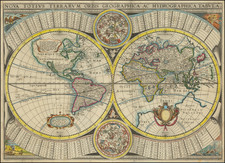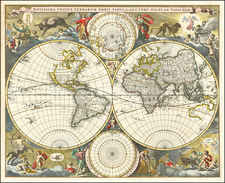One of the Earliest Thematic Maps -- The First Thematic Map Focused on Zoology
Map of the world showing the distribution of mammals or quadrupeds. As noted by Princeton's on-line exhibition on Thematic Mapping, Zimmerman's map is the:
first map of animal geography. . . It is the addition and geographical placement of the Latin names of quadrupeds that distinguishes the map from anything previously published. Castor (beaver), for example, appears throughout northern North America; leo (lion) in Africa; and kanguro (kangaroo) in northeastern Australia, where Cook's men first sighted one. Though very rudimentary in style and accuracy, the map marks an auspicious moment in the history of thematic mapping.
Zimmerman was one of the pioneers of "Biogeography." As noted in Origins of Biogeography, the true genius of Zimmerman's work is how he managed to meld natural histories and travelogues. Rather than producing a detailed systematic catalogue of different types of quadrupeds, Zimmerman produced a classification of where they are found.
When it was published, Specimen Zoologicase Geographicae was the only work that categorized the planet into known quadruped distributions . . .
. . . Zimmerman published Tabula mundi geographico zoologica sistens quadrupedes hucusque notos sedibus suis adscriptos (Zimmerman, 1777), possibly the first distributional map that gave certain Linnaean names and the distributions.
There appears to be at least 2 versions of this map, drawn from different copper plates. The John Carter Brown Library holds a copy with 2 columns of text to the left of the cartouche and 4 columns to the right, which on closer inspection are letterpress sheets pasted onto the map, bearing the imprint of "T Haas & Soc" Lugo Batarorum" and is dated by the JCB at 1777.
The present example would seem to have updated and improved cartographic features and more likely dates to the decade after the last of James Cook's Voyages, and bears the imprint "Joseph Marianus Sculp. Aug. Vind ." A copy of this map is found in the National Library of Australia.
Eberhard August Wilhelm von Zimmermann (1743-1815) was a German philosopher, biologist and geographer. He studied at the University of Leiden, Halle and Goettingen. He travelled a lot in Europe. One of his big publications was Taschenbuch der Reisen, 12 annual editions ( Leipzig 1802-1813).
http://libweb5.princeton.edu/visual_materials/maps/websites/thematic-maps/quantitative/natural-history/natural-history.html
Eberhard August Wilhelm von Zimmermann was a distinguished German philosopher, biologist, and geographer, celebrated for his pioneering contributions to the field of animal zoogeography. Born on August 17, 1743, in Uelzen, and passing away on July 4, 1815, in Braunschweig, Zimmermann's academic and exploratory endeavors significantly advanced the understanding of geographical distribution and natural sciences during the late 18th and early 19th centuries.
Zimmermann pursued his studies in natural philosophy and mathematics at several prestigious institutions, including the universities of Leiden, Halle, Berlin, and Göttingen. In 1766, he was appointed as a professor of mathematics and natural sciences at the Collegium Carolinum in Braunschweig, where he would go on to influence numerous students, most notably the eminent mathematician Carl Friedrich Gauss.
Zimmermann's academic career was marked by extensive travels across Europe, including visits to Livonia, Russia, Sweden, Denmark, England, France, Germany, Switzerland, and Italy. These journeys were not merely for exploration but were driven by his keen interest in researching economic conditions and natural resources. His observations and studies during these travels culminated in several influential publications.
One of Zimmermann's most significant works is Specimen Zoologiae Geographicae Quadrupedum (1777), which is regarded as one of the first comprehensive studies on the geographical distribution of mammals. This work laid the foundation for the emerging field of zoogeography and demonstrated Zimmermann's forward-thinking approach to understanding the natural world.
His major publication, Geographische Geschichte des Menschen und der allgemein verbreiteten vierfüßigen Thiere (Geographical History of Humans and the General Distribution of Quadrupeds), was released in three volumes between 1779 and 1783. This work illustrated the global distribution of quadrupeds and included the first zoological world map. The map drew on the latest geographical data of the time, such as James Cook's discovery of the Sandwich Islands (Hawaii).
Zimmermann was also a prolific writer on various subjects, ranging from mathematics and natural sciences to regional studies and the history of discovery. Among his numerous publications, the Taschenbuch der Reisen (Handbook of Travel), published in twelve annual editions from 1802 to 1813, stands out for its comprehensive coverage of geographical and cultural insights gathered from his travels.
In recognition of his contributions to science and his extensive research, Zimmermann was elected to the American Philosophical Society in Philadelphia in 1794. Throughout his career, he continued to publish influential works, such as Über die Elastizität des Wassers (1779), Frankreich und die Freistaaten von Nordamerika (part I, 1795; part II, 1800), and Die Erde und ihre Bewohner (The Earth and Its Inhabitants), a five-volume series published between 1810 and 1814.
Zimmermann's legacy as one of the founders of animal zoogeography and his significant contributions to the fields of geography, biology, and natural history remain influential. His work bridged the gap between medieval understanding and modern scientific approaches, setting the stage for future advancements in the study of the natural world.










![(World - First State!) Benedict Arias Montanus Sacrae Geographiae Tabulam ex Antiquissimorum Cultor. [Pre-Dutch Discovery Depiction of Australia]](https://storage.googleapis.com/raremaps/img/small/93232.jpg)

![Earth Atlantic View [Waterman Projection]](https://storage.googleapis.com/raremaps/img/small/86011.jpg)

